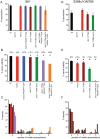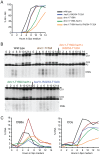Down-regulation of Rad51 activity during meiosis in yeast prevents competition with Dmc1 for repair of double-strand breaks
- PMID: 24465215
- PMCID: PMC3900393
- DOI: 10.1371/journal.pgen.1004005
Down-regulation of Rad51 activity during meiosis in yeast prevents competition with Dmc1 for repair of double-strand breaks
Abstract
Interhomolog recombination plays a critical role in promoting proper meiotic chromosome segregation but a mechanistic understanding of this process is far from complete. In vegetative cells, Rad51 is a highly conserved recombinase that exhibits a preference for repairing double strand breaks (DSBs) using sister chromatids, in contrast to the conserved, meiosis-specific recombinase, Dmc1, which preferentially repairs programmed DSBs using homologs. Despite the different preferences for repair templates, both Rad51 and Dmc1 are required for interhomolog recombination during meiosis. This paradox has recently been explained by the finding that Rad51 protein, but not its strand exchange activity, promotes Dmc1 function in budding yeast. Rad51 activity is inhibited in dmc1Δ mutants, where the failure to repair meiotic DSBs triggers the meiotic recombination checkpoint, resulting in prophase arrest. The question remains whether inhibition of Rad51 activity is important during wild-type meiosis, or whether inactivation of Rad51 occurs only as a result of the absence of DMC1 or checkpoint activation. This work shows that strains in which mechanisms that down-regulate Rad51 activity are removed exhibit reduced numbers of interhomolog crossovers and noncrossovers. A hypomorphic mutant, dmc1-T159A, makes less stable presynaptic filaments but is still able to mediate strand exchange and interact with accessory factors. Combining dmc1-T159A with up-regulated Rad51 activity reduces interhomolog recombination and spore viability, while increasing intersister joint molecule formation. These results support the idea that down-regulation of Rad51 activity is important during meiosis to prevent Rad51 from competing with Dmc1 for repair of meiotic DSBs.
Conflict of interest statement
The authors have declared that no competing interests exist.
Figures




Comment in
-
The sense and sensibility of strand exchange in recombination homeostasis.PLoS Genet. 2014 Jan;10(1):e1004104. doi: 10.1371/journal.pgen.1004104. Epub 2014 Jan 23. PLoS Genet. 2014. PMID: 24465222 Free PMC article. No abstract available.
Similar articles
-
Meiotic crossover control by concerted action of Rad51-Dmc1 in homolog template bias and robust homeostatic regulation.PLoS Genet. 2013;9(12):e1003978. doi: 10.1371/journal.pgen.1003978. Epub 2013 Dec 19. PLoS Genet. 2013. PMID: 24367271 Free PMC article.
-
Mek1 Down Regulates Rad51 Activity during Yeast Meiosis by Phosphorylation of Hed1.PLoS Genet. 2016 Aug 2;12(8):e1006226. doi: 10.1371/journal.pgen.1006226. eCollection 2016 Aug. PLoS Genet. 2016. PMID: 27483004 Free PMC article.
-
Rad51-mediated interhomolog recombination during budding yeast meiosis is promoted by the meiotic recombination checkpoint and the conserved Pif1 helicase.PLoS Genet. 2022 Dec 12;18(12):e1010407. doi: 10.1371/journal.pgen.1010407. eCollection 2022 Dec. PLoS Genet. 2022. PMID: 36508468 Free PMC article.
-
Repair of DNA double-strand breaks in plant meiosis: role of eukaryotic RecA recombinases and their modulators.Plant Reprod. 2023 Mar;36(1):17-41. doi: 10.1007/s00497-022-00443-6. Epub 2022 Jun 1. Plant Reprod. 2023. PMID: 35641832 Review.
-
The biochemistry of early meiotic recombination intermediates.Cell Cycle. 2018;17(23):2520-2530. doi: 10.1080/15384101.2018.1553355. Epub 2018 Dec 10. Cell Cycle. 2018. PMID: 30482074 Free PMC article. Review.
Cited by
-
SPO16 binds SHOC1 to promote homologous recombination and crossing-over in meiotic prophase I.Sci Adv. 2019 Jan 23;5(1):eaau9780. doi: 10.1126/sciadv.aau9780. eCollection 2019 Jan. Sci Adv. 2019. PMID: 30746471 Free PMC article.
-
The role of bivalent ions in the regulation of D-loop extension mediated by DMC1 during meiotic recombination.iScience. 2022 Oct 25;25(11):105439. doi: 10.1016/j.isci.2022.105439. eCollection 2022 Nov 18. iScience. 2022. PMID: 36388968 Free PMC article.
-
Biochemical attributes of mitotic and meiotic presynaptic complexes.DNA Repair (Amst). 2018 Nov;71:148-157. doi: 10.1016/j.dnarep.2018.08.018. Epub 2018 Aug 23. DNA Repair (Amst). 2018. PMID: 30195641 Free PMC article. Review.
-
Spontaneous self-segregation of Rad51 and Dmc1 DNA recombinases within mixed recombinase filaments.J Biol Chem. 2018 Mar 16;293(11):4191-4200. doi: 10.1074/jbc.RA117.001143. Epub 2018 Jan 30. J Biol Chem. 2018. PMID: 29382724 Free PMC article.
-
Homologous Recombination and Repair Functions Required for Mutagenicity during Yeast Meiosis.Genes (Basel). 2023 Oct 28;14(11):2017. doi: 10.3390/genes14112017. Genes (Basel). 2023. PMID: 38002960 Free PMC article.
References
-
- Petronczki M, Siomos MF, Nasmyth K (2003) Un menage a quatre: the molecular biology of chromosome segregation in meiosis. Cell 112: 423–440. - PubMed
-
- Hassold T, Hunt P (2001) To err (meiotically) is human: the genesis of human aneuploidy. Nature reviews 2: 280–291. - PubMed
-
- Sheridan S, Bishop DK (2006) Red-Hed regulation: recombinase Rad51, though capable of playing the leading role, may be relegated to supporting Dmc1 in budding yeast meiosis. Genes Dev 20: 1685–1691. - PubMed
Publication types
MeSH terms
Substances
Grants and funding
LinkOut - more resources
Full Text Sources
Other Literature Sources
Molecular Biology Databases
Research Materials

